the lens of Marxist Criminology and Land Rights Distribution Patterns in South Africa. Compiled by: Izindoni

The structure of the reflection……… ……………………………………….. 1 Contextualising of site The physical space………………………………………………………………..…2 The Hisory of Central Gold Mine…………………………………………………3 The Economic space………………………………………………………………..4 The Political space…………………………………………………………………5… Neoliberalism as a political approach………………………………………….. :……………………………………………………………………6 Justification of research object : Mine…………………….…………………8 Marx and Weber’s debate on the primitive accumulation of capital and socialism………………………………………………………………………9-10 Continuation of the debate…………………………………………………. 11 Differing views on crime…………………………………………………… 12-13 Linking to core readings The State as a Masculinist Protectionist……………………………………..13 Mining Policy stands as an empty signifier of State Control of Mineral Resources………………………………………………………………………..….14 Critiquing equity, democracy, legitimacy and recognition of diversity in illegal mining (The Just City, Susan Fainstein)……………………………..15 16 The analysis of internal illegal mining conflicts in South Africa catalysed the rise in power of Ghana as Africa’s top gold producer (The New World order, Ray Dalio)……………………………………………………………………………16 -17 Locally implemented solutions………………………………….. Conclusion………………………………………………………………… Reflection questions and Project schedule…. 17 -18 References……………………………….. 19-25 Gugulethu Mashego (2544689) and Itumeleng Nkosi (1702687) Group name: Izindoni Object of analysis: Mine Positionality and perspective: Reflections on Crime as Land Theft (Capitalism's Original Sin) from a Marxist Approach Format: Scrapbook Site: Central Gold Mine, Zamimpilo Informal Settlement and Riverlea, Region G, Johannesburg The structure of the reflection This Reflection will begin with the contextualization of the studied object through the history of Mining in South Africa, and the writers’ positionality based on Marxist theories. This will be hand in hand with an analysis of Region G, ward 68, where there is a conflict over land and mining rights. The perspectives of Karl Marx, Pierre Proudhon and Max Weber on ownership of property and land management will be used at a broad scale to examine how the ownership and mismanagement of mining land by the South African Capitalist Bourgeoisie can translate into the Zama Zama, Riverlea and Zamimpilo conflict over illegal mining. That will lead to an investigation of how the law can be a method used to oppress the proletariat and how it has assisted in keeping the mining right in Bourgeoise ownership. Thus, Marxist criminology can be used to explore crime as a consequence of the proletariat protest against modern capitalism. This is seen in Region G, where the dispute over the mine rehabilitation before the mine closure, between the former owners of the mine, Central Rand Gold and the Department of Mineral Resources has led to the criminal territoriality of the mine and surrounding settlements. The conclusion will be formed by linking studied materials and graphic representations of our analysis related to our object’s role in crime and safety in Johannesburg. 1
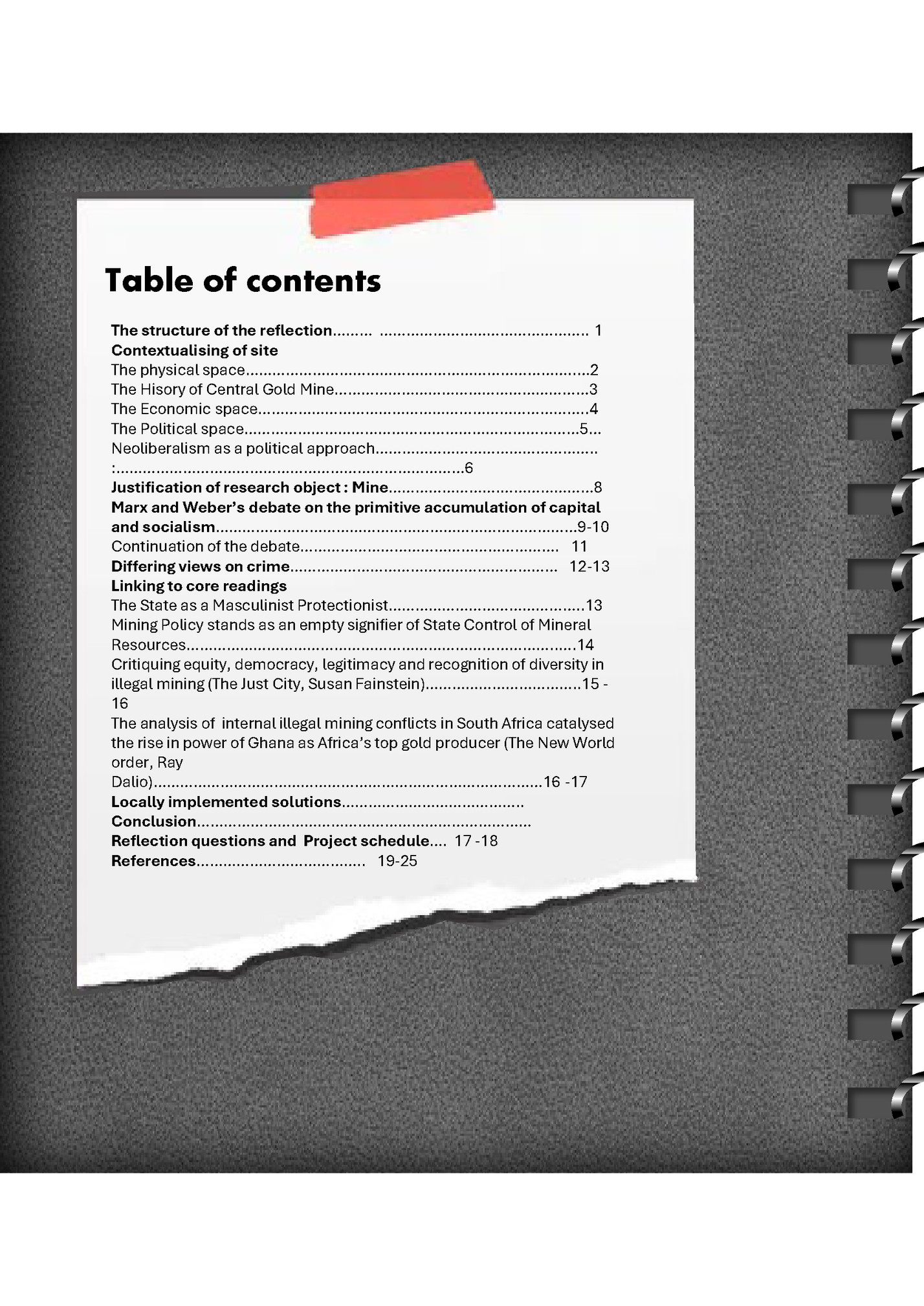
The History of Central Gold Mine: Central Rand Gold was previously owned by Central Rand Gold (Pty) a company which received mining Rights to Mine the Land in Riverlea in 2008/9 and began mining operations in 2010. The company then went bankrupt in February 2019 and abandoned the mine. It is one of the 6000 abandoned mines in South Africa (Tshangela and VincentBester, 2019). History of Mining in South Africa: Following the discovery of Gold by Australian Prospector Geroge Harris in 1884, (Joburg History, 2022) there were several measures put in place by the then South African Government which placed the power to mine and own the land in the hands of Whites (DMRE, 2023). One of these was the South African Act 1909 which consolidated power in an all-white parliament and allowed them to pass consequent laws such as the Mine and Works Act of 1911 which restricted mine ownership and introduced the “Colour Bar” for employment (Roback, 1988). The Colour bar was passed due to the pleas of white Afrikaaner trade unions to actively prohibit Native South Africans from working on any mining operations except deep shaft labour (DMRE, 2023). Racial exclusion of Black Natives was furthered through the 1913 Natives which strategically moved native blacks far from the mining belt to allow unhindered access to white owned mining companies. Figure 5: A context map of Central Gold Mine in Johannesburg South (Nkosi, 2024) The Mine but has since been liquidated by the Department of Mineral Resource Energy (DMRE). The Responsibility for Rehabilitation and the Rights to use the land was granted to Amatshe Mining (Pty). However, Amatshe Mining (Pty) was held in deadlock conflict with the Landowners of the mine (a company called iProp) who refused Amatshe Mine access to the land in order to perform the rehabilitation work (DMRE, 2023). The Company Central Gold had been required to make financial provisions for rehabilitation to the value of R44 774 902.01 for the negative impact which may be caused by mining activity. Through these funds DMRE prides itself on determinedly implementing the rehabilitation process and sealing 34 mine shafts. However, there is heavy criticism regarding for the further 24 still open mine shafts. Some of these shafts are located in Zamimpilo Informal Settlement and Riverlea Suburb. Some new shafts have been opened from and hidden in rooms of houses. Nhlengetwa, 2014) 2024 2 Figure 3: Signs showing Segregation Laws of Apartheid promoting all-white spaces (Millerha, 2024) Figure 4: one of the First on the mining camps in Johannesburg Gauteng (Mining Map South Africa, 2017) Figure 6 :A context map of Zamimpilo Informal Settlment, Riverlea and Central Gold Mine (Nkosi, 2024) Figure 7: A Zama Zama Miner exiting an open Mine shaft (Hedricks, 2023) 3
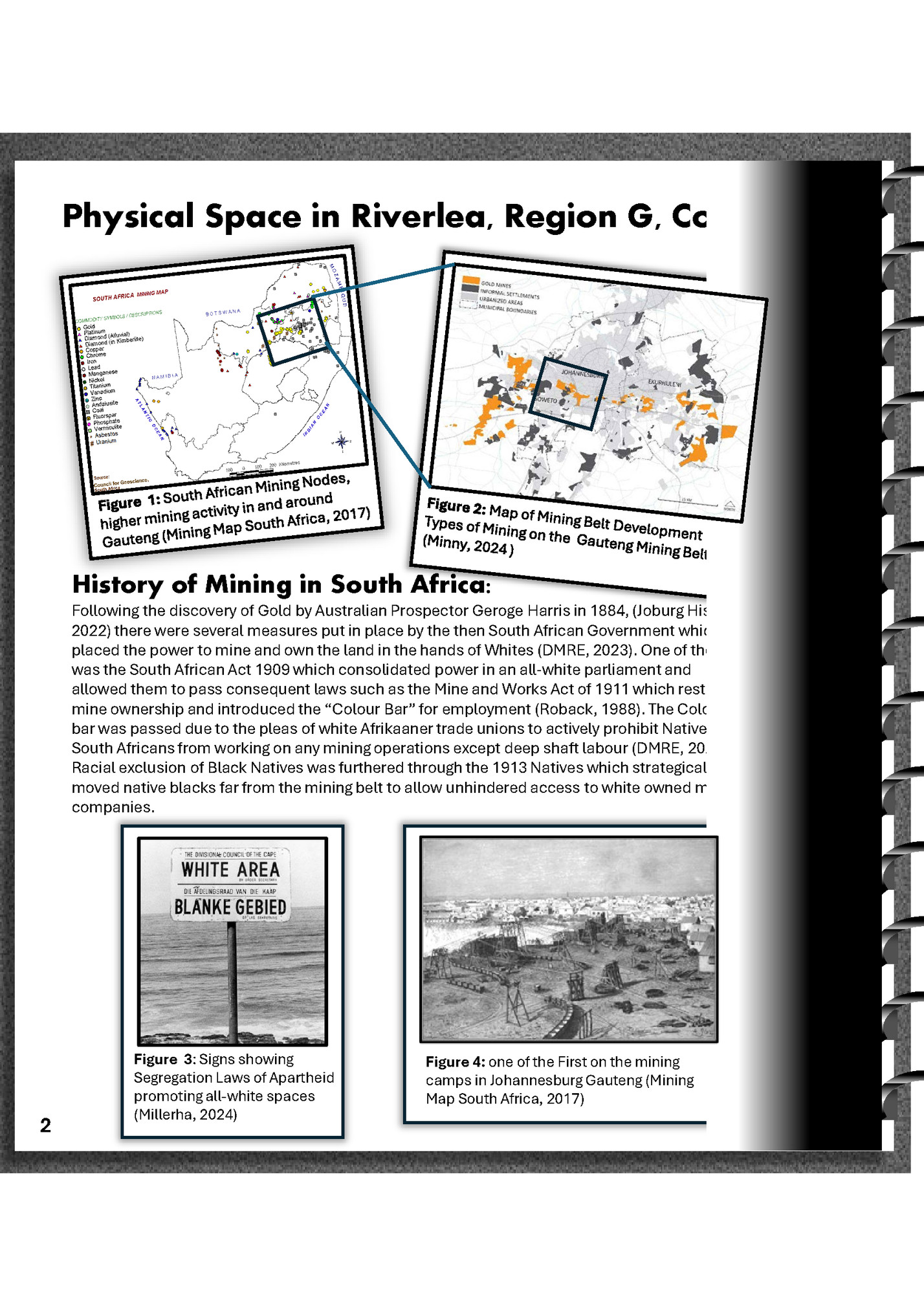
Economics in South Africa: The exclusion from Capital ownership has led to high Unemployment rates especially in previously disadvantaged “Black” peoples of South Africa. The unemployment rate has been on an upward trend from 24.34% in 2020 to 33.5% in the second quarter of 2024 (that is an 0.6% increase from 32.9% in the first quarter of 2024 and a 1.4% increase from 32.1% since the last quarter of 2023) (Stats SA, 2023: 2024). The unemployment rate has contributed to the 55.5% the South African population living below the food poverty line which is R760 (as needed per person per month to fulfil the minimum nutritional standard daily caloric food intake of 2100 calories per day). Despite setting the standard for caloric intake, the food poverty line excludes the expenses for non-food items which are required for daily life. Therefore, the lower boundary poverty line (R1058) factors other essentials such as clothing but still assumes that nutrition will be sacrificed for the other basic needs. The upper boundary poverty line (R1558) represents just enough money to fulfil nutritional needs and needs such as clothing but it does not account for the cost of housing which is also a basic need. (Stats SA, 2023) 4 Figure 9: The desperate need for employment in South Africa makes people exploitable by private sector businesses despite implementations if minimum wage programs and unionization especially in the mining Sector (Loyd, 2021) The Minimum Wage Standard: Proportion Employment in South Africa Employed Unemplyment The minimum wage in South Africa is one of the strategies to address the issue of employers paying low wages and all employers are mandated to pay workers a minimum of R27.58 (an increase from R25.42 before 1 March 2024) (Stats SA, 2023). However despite the progressive nature of the Minimum Wage Act 2019, most employers do not comply, leaving workers earning much below R5049.76 per month for a fourty hour work week. The minimum wage for expanded public works programme is lower (at R15.16 per hour, less than R2 500 per month) and also does not take it into account part time workers who take home a much lower rate than those above this has given rise to not only an unemployed but Poverty Stricken Citizens who are desperate for means of income and are vulnujrable to temptations of crime and the expression of frustration by Violence. Portion of Minimum Wage Salary Food Security For One Lower Boundary Poverty for One Upper Boundary Poverty Line For One Remainder 18% 20% 37% 25% 5
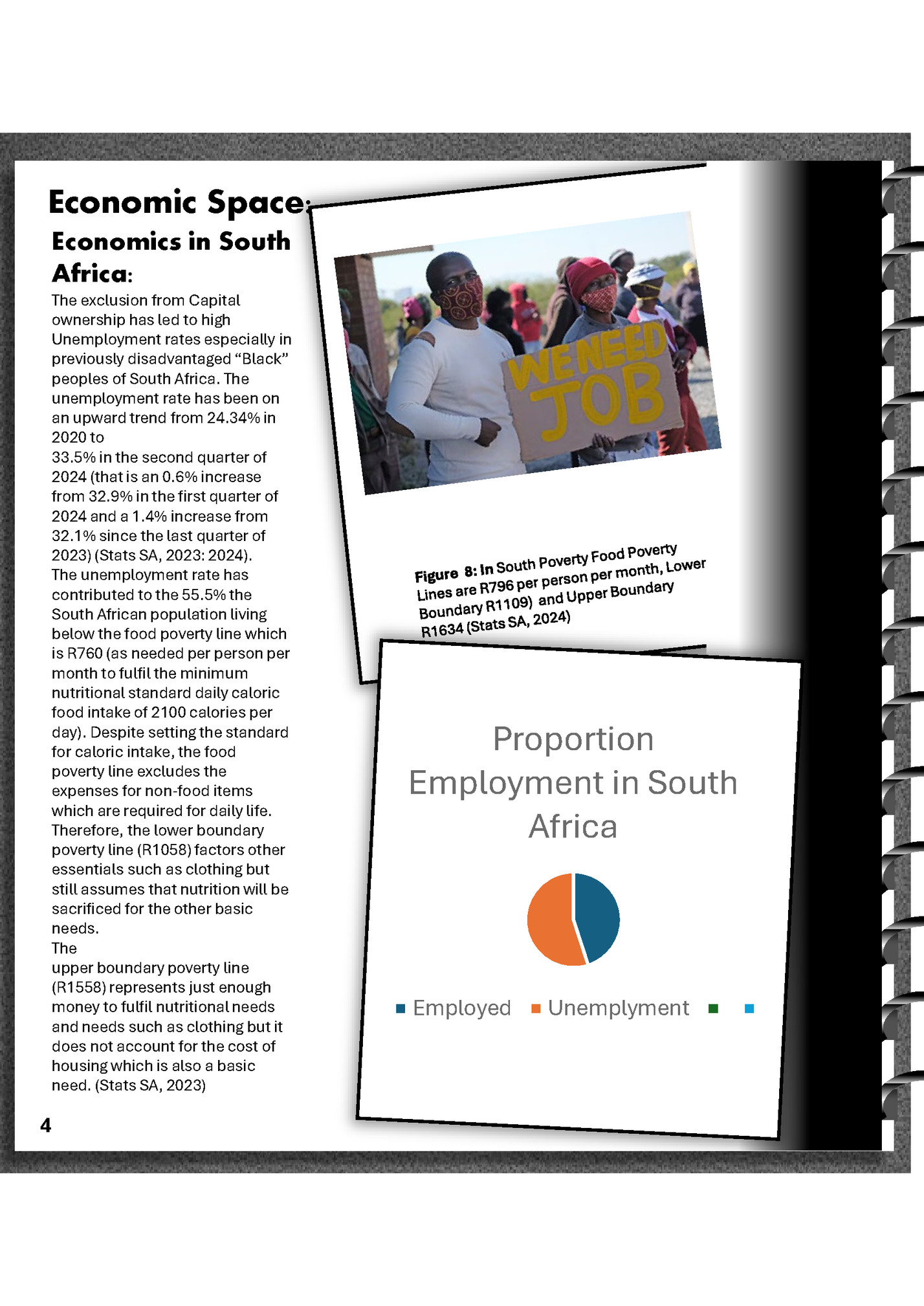
Political Space: Neoliberalism works by structuring policy environments all around the world by garnering the perception it is the solution to all countries’ deep rooted internal social problems . Therefore, Neoliberalism has been naturalized as a ‘common sense solution’ but instead what it is a system of enforced and selective silences which downplay alternative political approaches leaving States to become Neoliberized in a deep but indirect way. Politics In Johannesburg South Africa and Johannesburg South: The City of Johannesburg and South Africa have been led by the ANC since the 1994 Elections. It is no secret that the ANC favors the protection of Private Property Rights as well as Neoliberal Policies which celebrate the free market. The ruling party has a large impact on the hegemonic political approaches in the country and in on of the Country’s most populous metros Johannesburg Jamie Peck gives the analysis which outlines Neoliberalism as a political approach which has been commonly adopted by third world countries where structural and political readjustment often takes place in the face of globalization. Within the system of Neoliberalism, the state practices deregulation (where the intensely competitive international markets markets are given the political conditions to reign free) and celebrates the principles of individualism, competitiveness and economic self-sufficiency. 6 Figure 12: Neoliberalism is a view which holds capital and trade above all else, even ignoring the limited access it allows citizens to benefits which are kept for capitalists. (Zulu, 2021) 2024 In a neoliberal system, Social transfer programmes are weakened because the poor are only given inclusion, on the market’s own terms. The state is often reduced to mere market managers especially in the cases of Labour, Environmental policy and in the regulation of privatized industries. This can be in line with the Marxist theory that the state is simply manager of the affairs of the bourgeoisie The methodologies of neoliberalism include not only Deregulation, Privatization and the dominant enforcement of private property rights which “… not only permit but positively promote income inequality, unstable work and underemployment…” (Peck, 2000, p453) the conditions of capitalism promote Plutocracy (Kornai, 2000), that is: a society ruled by the wealthy, it is considered a corrupt society this is because it is commonly leaving the poor marginalized from social, economic and political life by leaving the poor struggling between unemployment and working dead end jobs. This inequality has manifested as the prioritization of the middle class and the implementation of disciplinary measures to the socially excluded labour force. The System's selective chronic underinvestment into social, economic and physical infrastructure render Neoliberalism highly unstable despite being seemingly legitimized by the Global North. (Peck, 2000) Figure 13 Neoliberalism takes most of its influence from European Standards (Gunner, 2020) Figure 14:Neoliberalism integrates Globalism at the cost of Context Specific values and traditions ( 7
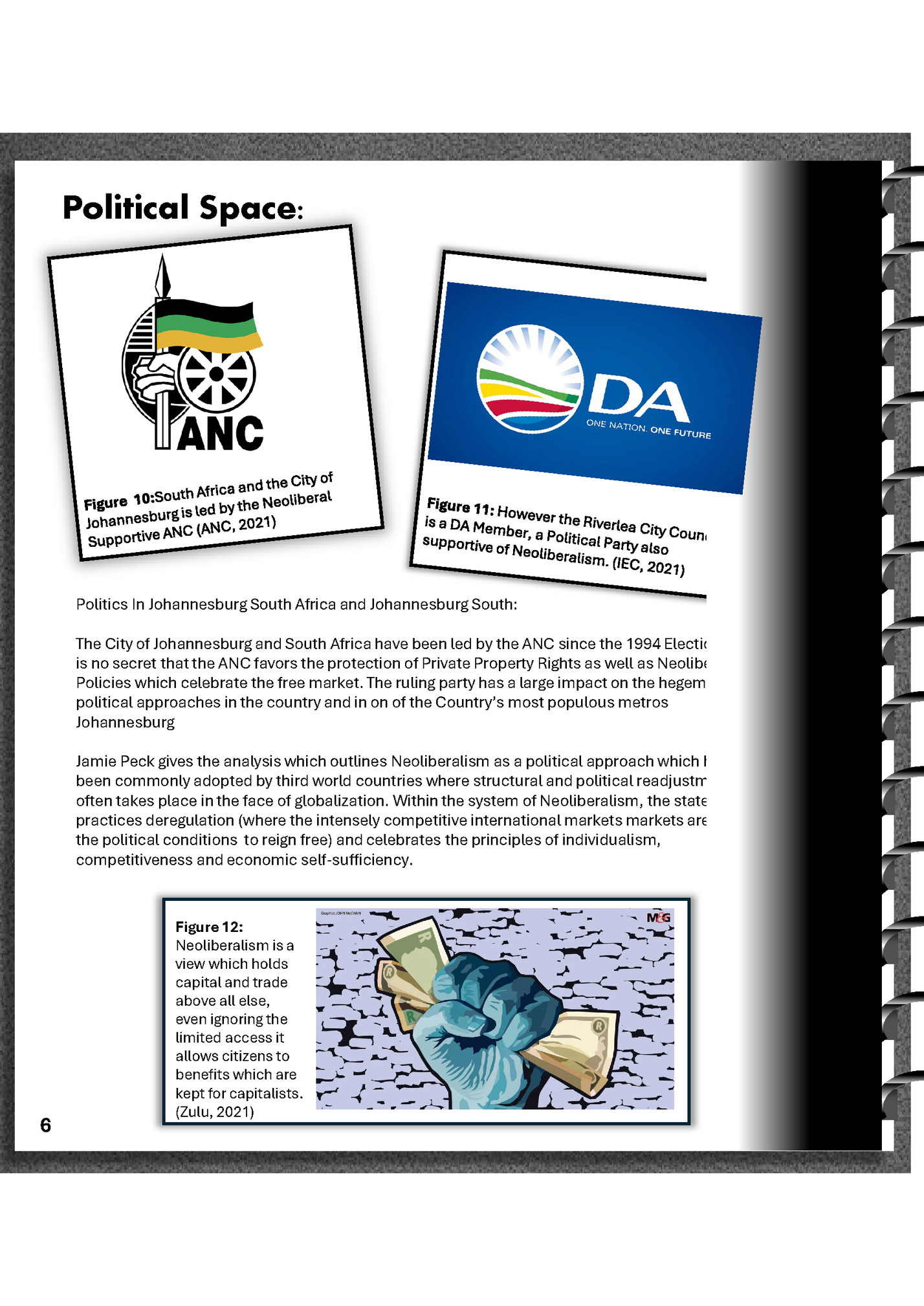
Mine Mines provide essential minerals and metals such as gold and copper which are important for capitalist industrial economy. Mining forms 7.53% of South Africa’s GDP (Minerals Council, 2023) by contributing to the national economy through generating revenue and creating job opportunities. The mined metals are utilized in infrastructure development of roads, electricity lines, bridges and other infrastructure. Other mined minerals such as nickel and lithium are utilized in communication, movement and in renewable energy technologies. Therefore, mines form the foundation of the Capitalist economy which privatizes the means of production to sustain Bourgeoise wealth while exploiting the proletariat. Figure 16: Illegal miner exits mine shaft (Mlangeni, 2018) 8 People need access to the mines and its wealth to survive and thus it is a resource most vulnerable to exploitations and crime. Mine ownership can be questioned as a crime through the lens of historical materialism. It is due to mine ownership that there is dispute mine usage which can lead to conflict between those who own the land and those it was stolen from. Unregulated use of land can lead to environmental degradation through vegetation removal and uncontrolled resource extraction such as illegal mining which further perpetuates the crime on the land. Therefore, it is important to understand that mines affect all factors of life whether economically, environmentally or socially. Marx and Weber debate on primitive accumulation of capital and socialism. Karl Marx’s theory of historical materialism states that the history of the world has been shaped by the conflict between two classes: the ruling class (that is the owners of the factors of production) and the labour providing proletariat. He views Capitalism as a form of Primitive accumulation occurring through the privation of common land and the undermining of communal property rights. His theory of primitive accumulation can be observed in how the Bourgeoise being the owners of the means of production (Central Rand Gold mine) have taken ownership of the land, exploited and discarded it without following due procedures thus leaving it vulnerable to Zama Zama takeover. This can be seen as a form of primitive accumulation through crime which can be defined as: direct and violent “seizure, confiscation and robbery” (Marx, 1989). Figure 17 : Capitalism and Land Dispossession go hand in hand (Sketchit, 2024) Figure 18: Graphic showing the Land Grabbing Conflict and protesting native workers (Samriddhi Foundation, 2018) He argues that the land dispossession is driven by exploitation, alienation, the manifestation of class struggles and inequalities in the capitalist’s system. He states that in the creation of a capital system “once a worker is freed from a system of slavery or serfdom and becomes a free worker, that worker later sells his labor to the capitalist, entering a wage-labourer bondage” (Marx,1989.). in South Africa, this is wage-laborer bondage is further enforced through the law mining rights licensing to keep the proletariat from becoming independent miners and economically benefitting from the land, keeping wealth in the hands of large international corporations Figure 19: Capitalism is coveting shared resources (Adobe Sketch, 2024) 9
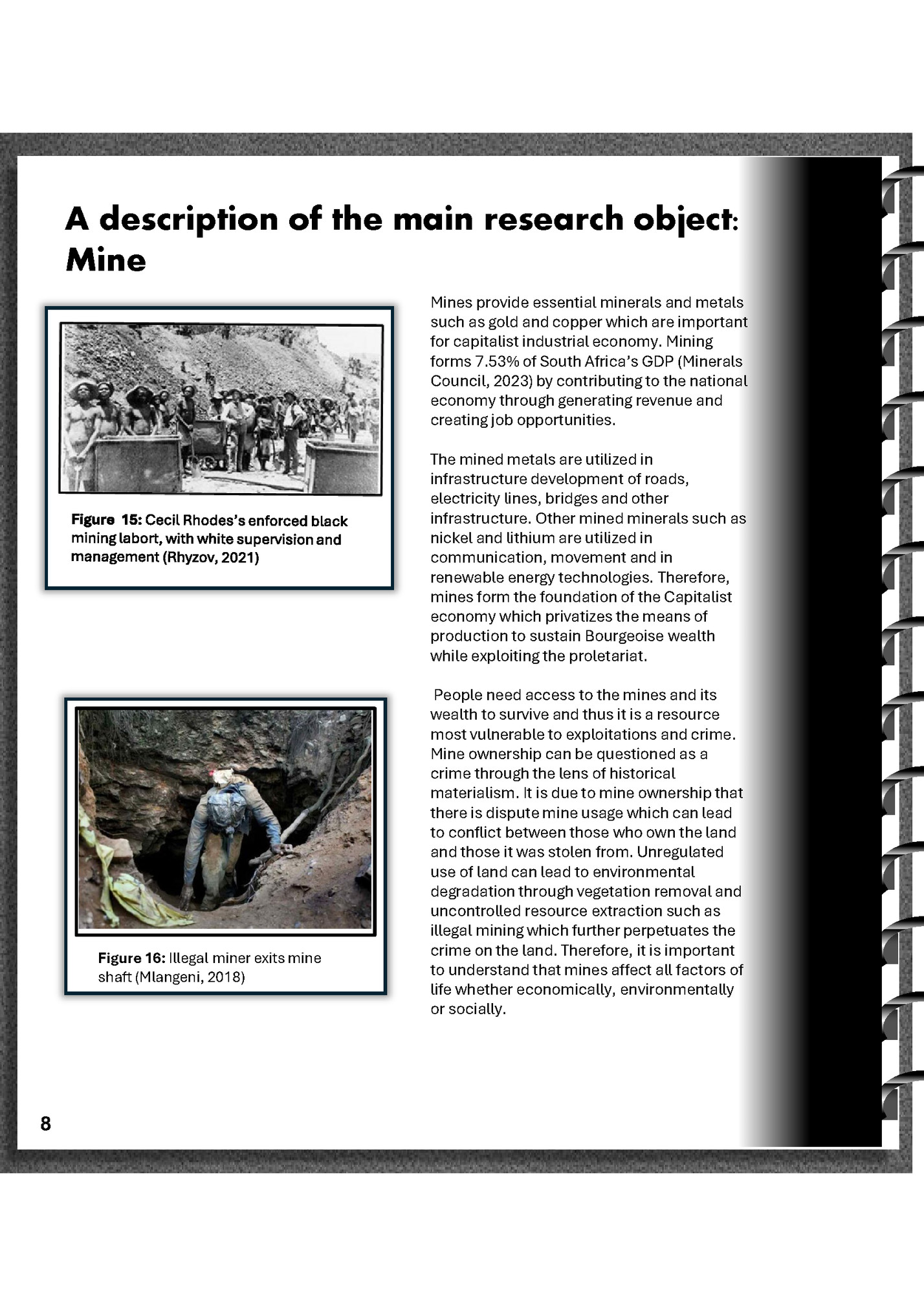
Figure 20: Abandoned open mine shaft due to negligence of CRG Mine after mine closed due to bankruptcy, a cause for This can be seen clearly in Rivelea, Johannesburg where the sudden closure of Central Rand Group Gold mine reduced their mining workforce by 80% (Mining Safety, 2020) and later left the whole mine’s proletariat unemployed, despite the availability of mineral resources and the skill of labour. The mining shafts however were left unclosed due to legal conflict between the mine and the Department of Mineral and Petroleum resources (Mekuto, 2023). Which left the shafts open to artisan miners (the Zama Zamas) who have now become the pseudo-owners of the mining territories. Karl Marx argues that the Base of Society will always be Capital or Resource based and the overlaying social elements such as law enforcement and politics are simply a superstructure which maintains the unequal relationship between the owners of the means of production and the labour force. In the instance of The Central Rand Gold Mine owners leaving the mine shafts unclosed, the law enforcement was passive and did not sufficiently ensure that mine rehabilitation was completed, posing a risk to Riverlea and Zamimpilo settlements (Mekuto, 2023). The current law enforcement has also failed to carry out the mandate of land management and anti-land exploitation policies that in theory are meant to prevent illegal mining, and if it takes place, to ensure that the illegal operations cease The failure of the law enforcement to protect residents has led to a lack of trust of in the state to uphold its own laws, therefore the communities of Riverlea, Zamimpilo and surrounding settlements, have taken to the streets to protest for government protection and intervention. Riverlea resident complaints against CRG. (Tshangela, 2019) Figure 21: Five Illegal miners dead over shootout mining territory conflict in Riverlea (IOL, 2024) 10 The conflict now involves three parties: the capitalist owners of the mine who own the land and mining rights, the zama zamas who are illegally operating in the mine (in most cases getting away with it) and the former proletariat who reside in the surrounding neighborhoods who despite belonging to and having worked the land are barred from formally mining it. The conflict has also become is multidimensional as it involves not only ownership but mismanagement of mines by the bourgeousie which can allow for a new foreign opportunistic mining ruling class to rule through violence and terrorism. Figure 22: Zama Zamas can be trapped in tunnels for moths (Trenchard, 2022) The new opportunistic miners also have internal conflicts over mining territories resulting in gun violence which is not only affecting the gangs fighting over mines but also the surrounding communities. This creates an unsafe environment for nearby residents as they are at risk of the mining territories and share them equally rather than surrender them to foreigners. being shot at and are vulnerable to hazards such as sinkholes which are exacerbated by the unsafe mining practices. The protests by the people of Riverlea and suurounds can be an example of Karl Marx’s argument that the marginalising and suppressing conditions of capitalism will force the Proletariat revolution (Marx and Engels, 1848, The Communist Manifesto). If these protests are unheeded we may find a situation where the region G communities will repossess 11
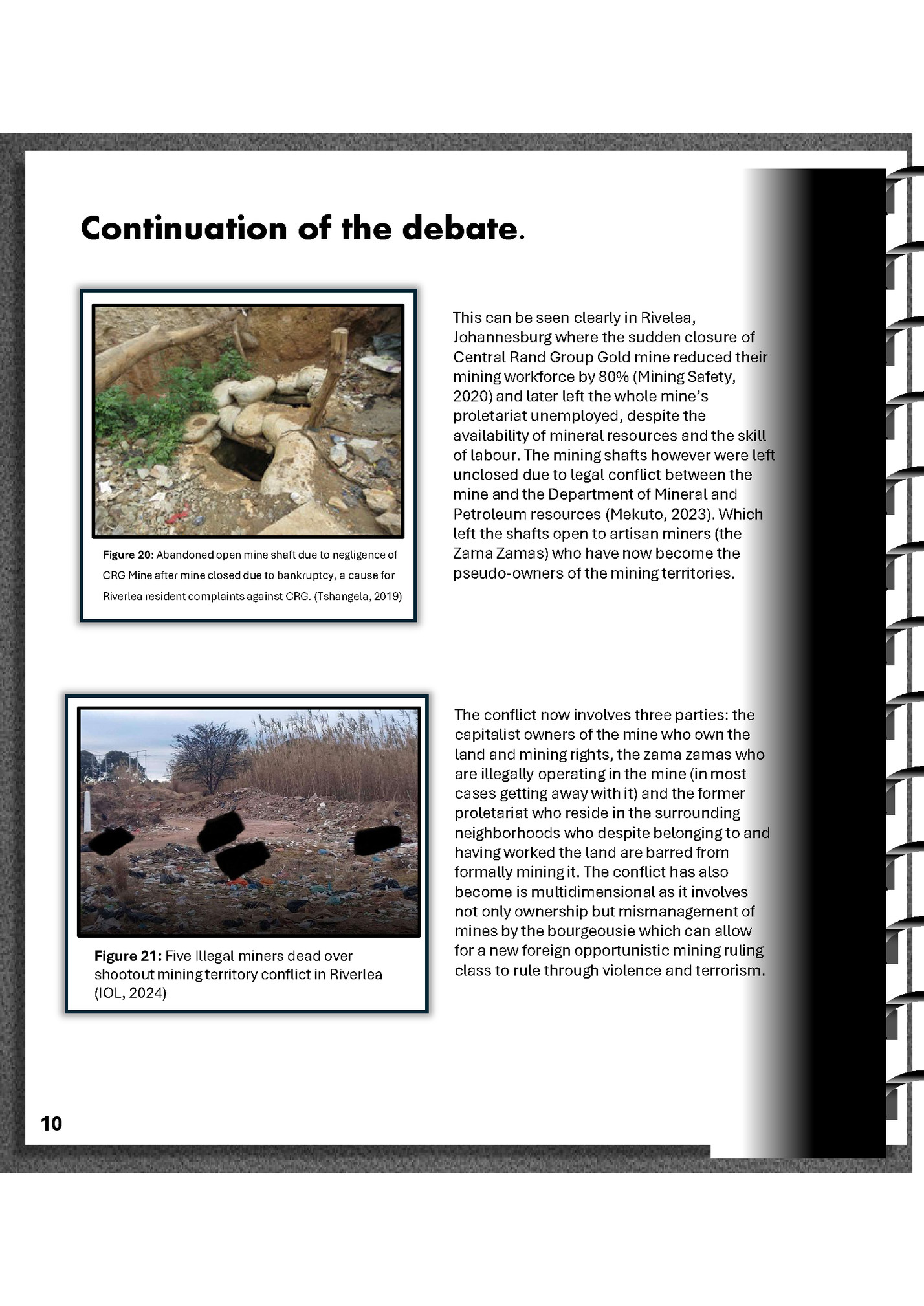
Georg Hegels's opinion is that the criminal is a free and self-determined being who must accept the retaliation to his infringement upon the rights of others. (Marx, 1853). This supports the protests of Riverlea residents for law enforcement and the justice system to persecute illegal miners and see them permanently removed from the area. It can be said that the activities of the Zama zamas are also an infringement on the rights of residents (as citizens) to have a share in the mineral resources of their country over foreign capitalist forces (Mining Safety, 2020). Figure 24: Illegal miners arrested after being caught in illegal mining shaft in Zamimpilo Informal settlement (SAPS, 2023) Figure 25: Illegal miners arrested after being caught in illegal mining shaft in Randfontein (Botha, 2022) In opposition to this, Karl Marx argues that the criminal is an individual “with multifarious social circumstances pressing upon him” and states that if society produces crime with increasing regularity, then it is the system which should be questioned and altered (Marx, 1853). This argument can be seen as apologetic to crime as it excuses the criminal’s incentive to commit crime due to circumstance which may not be the case, as the intention can sometimes be capital gain for the sake of capital gain. Pierre-Joseph Proudhon once stated that “Property is theft!” (Proudhon, 1840), specifically he meant Private Land (such as mines) because he analyzed that all private real estate can be traced back to theft and robbery. This statement helps to frame the question of what exactly is the crime, could it be the historical marginalization of South African Natives from owning the mining lands and forcing them into the labour class through land dispossession? Therefore, it calls also calls into question the system of private ownership of land by foreign colonial forces and the Neoliberal system’s protection of those property rights which allow exploitation, degradation and abandonment of the environment by negligent landowners. Marx opposed the statement that property ownership is crime as he states that ownership can only be defined by Bourgeoise Law and is a consequence of an unjust system but in a communist state without the ideas of ownership, theft cannot exist. It is reported that Marx considered the Property is theft rhetoric “a pointless appeal to Bourgeoise morality or conscience” instead of society embracing the revolutionary cause to abolish an unjust system through the proletariat revolution to repossess the means on production and establish a communist society. Despite Jamie Kornai stating that Communism is not natural and is imposed onto society, (Kornai, 2000), Marx’s disagrees and states that communism will be inevitable. (Shayn, 2020). Figure 26: Riverlea Residents protest illegal mining activities through road closure (IOL,2023) Figure 27: Representation of Mob Justice Practices in African Communities (Peterside, 2022) 12 The writers can also argue that the crime in Riverlea is a manifestation of Marxist criminology which states that the common acts of crime are a manifestation of the protest from the lower proletariat class as they struggle for economic, social and political equality in the Capitalist society (Hepler and Poortvliet, 2023). This can be true as the history of class struggles can be applicable to all of Africa, and it can be said that the Zimbabwean Zama Zama’s are also fighting for a rise in social status through crime. However, the writers can not be apologists of crime and acknowledge that the actions of the illegal miners have a negative effect on the republic and its citizens. 13
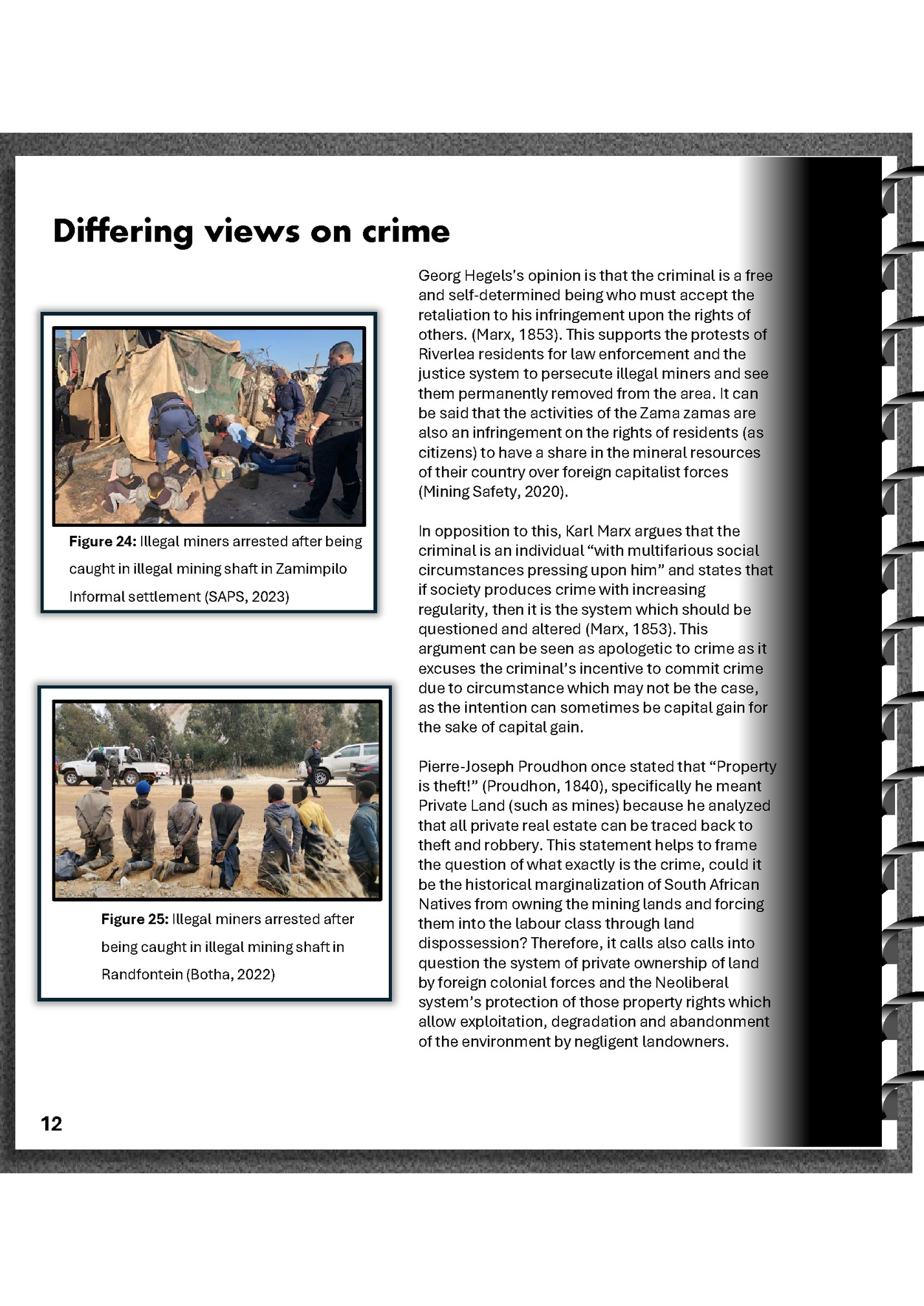
and recognition of diversity in illegal mining (The Just City, Susan Fainstein) Illegal mining has significant impacts on the economic, social and environmental sustainability of countries globally. This practice has perpetuated social and environmental injustices that undermine the quality of life of many communities. The principles of legitimacy, equity and democracy in illegal mining are critiqued by Susan Fainstein in ‘Just City’ as not being met by the practice. Illegal mining fails to meet the fundamental justice framework set by Fainstein that emphasizes on distributive justice, legitimacy, equity and recognition of diversity. Distributive justice Distributive justice prioritizes the equitable distribution of resources, revenue and power among stakeholders. Illegal mining highly compromises this principle as profits from illegal mining only benefit the Zama Zamas Zamas while the Riverlea and Zamimpilo communities are left to bear the brunt of environmental degradation, health risks and social displacement. The unequal distribution of revenue perpetuates existing social inequalities, exacerbating marginalization and vulnerability. The Illegal electricity connections in Roodepoort due to illegal mining have led to power disruptions in the area. Critical electricity infrastructure is as risk of collapsing. The stealing of copper cables by Zama Zama’s amount to a total of R3.5 million in repairs. These activities have put the local residents at risk of shack fires, electrocution and has increased power outages. The communities of Riverlea and Zamimpilo have received no compensation for land use, loss of livelihood, environmental damage and the violation of their right to fair compensation and restitution. The disregard for distributive justice also manifests in the lack of investment in lowincome settlement’s infrastructure which can improve living standards. 14 Figure 28 : Achieving equity to enable access to equal opportunities. (Okada, 2024) The prioritization of short-term economic gain shows the consequences of The Tragedy of the commons. In this theory, short-term individual benefit overrides the collective long-term interests. Garret Hardin argues that when multiple individuals such as the Zama zamas and the bourgeoisie, exploit shared resources, they rationalize that their actions will not have a significant impact on the overall sustainability of mining. However, cumulative damage environmental and economic damage amount resulting in Zamimpilo and Riverlea residents losing access to clean blue water and air (Hardin, 1968). The unregulated and unauthorized deforestation, biodiversity loss and pollution boosted by Illegal mining excabates environmental degradation. The mining process requires the use of toxic chemicals and materials that are destructive to the environment. The incorrect use of these chemicals combined with limited skills and equipment, illegal mining contaminates waters sources, the air and degrades the soil (Pan African Resources, 2024). This makes the local soil infertile for farming by the residents. Zama zama’s also use high amounts of water to process mineral material, reducing the water available to local communities resulting in competition for arable land and water resources. The South African government struggles to regulate illegal mining due to corrupt practices and the lack of response to illegal mining concerns from local communities further perpetuate this tragedy. Figure 29:Abandoned mines in South Africa(Auditor General South Africa, 2009) Figure 29 : Land Degradation Patterns in South Africa, (Bhengu et al, 2009) 15
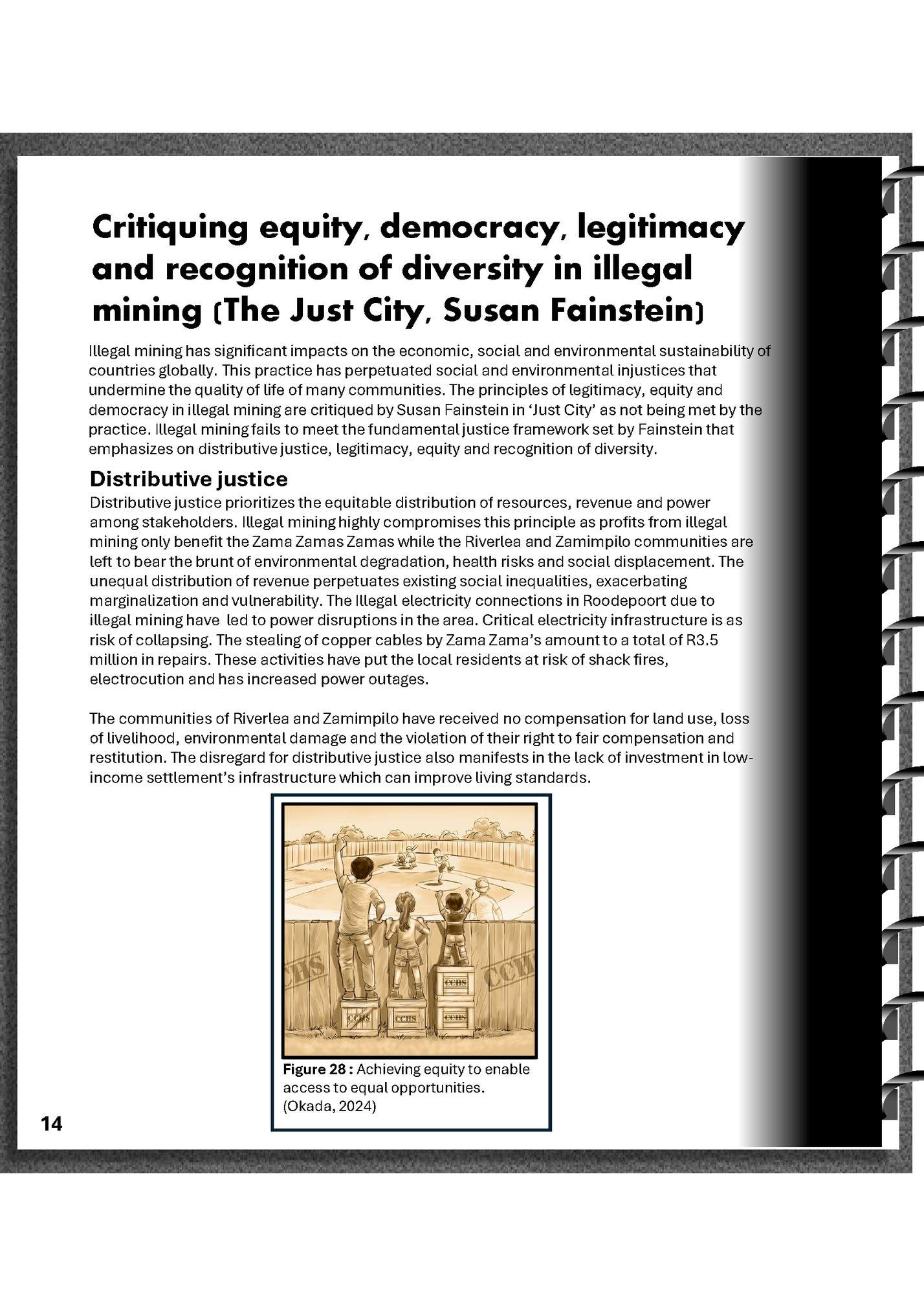
Fleepit Digital © 2021